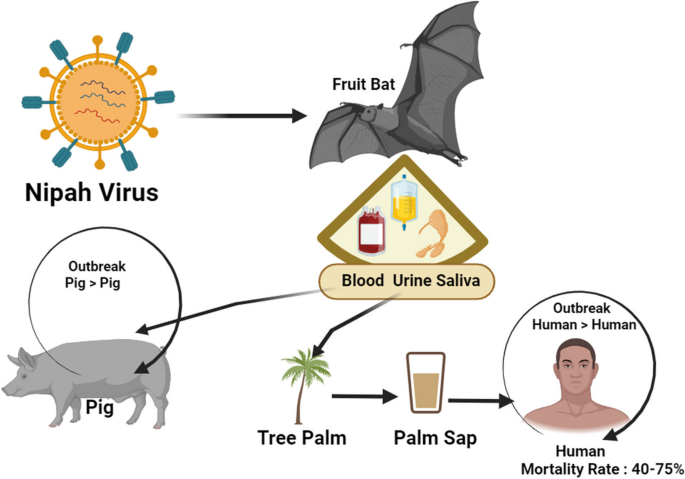Context
Kerala has once again come under the grip of the Nipah virus (NiV) following the confirmation of two suspected cases—an 18-year-old girl from Kozhikode who succumbed to Acute Encephalitis Syndrome (AES), and a 38-year-old woman from Malappuram, confirmed to be infected by the National Institute of Virology (NIV), Pune. This has reignited public health concerns, especially as the state recovers from earlier outbreaks in 2018, 2021, and 2023.
About the Nipah Virus (NiV):
- Nature: NiV is a zoonotic virus (transmitted from animals to humans) belonging to the Paramyxoviridae family, genus Henipavirus.
- Origin: First identified in Malaysia in 1999, it spread through pigs and infected humans.
- Indian Context: First outbreak in Siliguri, West Bengal (2001) and then in 2007. Kerala has seen repeated outbreaks since 2018.
- Structure: NiV is a negative-sense single-stranded RNA virus with envelope proteins (F and G) that allow it to enter human cells.
Transmission
Nipah virus spreads through:
1. Direct contact with infected animals (fruit bats, pigs).
2. Consumption of contaminated fruits or food (e.g., fruits licked by bats).
3. Human-to-human transmission, especially in healthcare settings.
Symptoms and Disease Progression
- Early symptoms: Fever, headache, sore throat, muscle pain.
- Progression: Drowsiness, dizziness, neurological issues, acute encephalitis.
- Severe cases: Seizures and coma within 24–48 hours.
- Mortality rate: High—up to 75% in some outbreaks.
Diagnosis and Testing
Detection is carried out using:
- RT-PCR
- ELISA
- Serum Neutralization Test (SNT)
- Immunohistochemistry (IHC)

Treatment and Vaccines
- No specific treatment or vaccine available.
- Ribavirin, an antiviral, may reduce mortality.
- Supportive care in ICU settings is the primary approach.
Nipah: A Regional and Global Concern
- Global presence: Detected in Bangladesh, Cambodia, Thailand, Ghana.
- Bangladesh and India: Most recurrent outbreaks, often seasonal and region-specific.
- India’s hotspots: Siliguri, Kozhikode, Malappuram.
1. Multiple transmission routes: Zoonotic and human-to-human.
2. No vaccine or definitive cure.
3. Healthcare worker risk during treatment and autopsy.
4. Quick neurological progression, limiting response time.
Preventive Measures and Recommendations
- Surveillance in bat habitats (e.g., flying foxes – genus Pteropus).
- Avoid consuming partially eaten fruits or date palm sap.
- Safe burial practices and hospital infection control.
- Early detection tools and mobile labs in high-risk zones.
- Research and R&D funding for vaccine development.
- Drones for wildlife surveillance and environmental testing.
Conclusion
The resurgence of Nipah in 2025 is a stark reminder of the unpredictable nature of zoonotic diseases. Kerala’s proactive response, drawing on past experience, may help contain the spread. However, the lack of vaccines, dual-mode transmission, and the fatal nature of the virus necessitate long-term public health planning, research investments, and community awareness.






